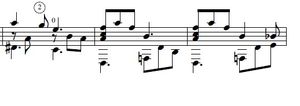This is a short lullaby or barcarolle – not something you’d describe as a major composition, but a piece I’ve remained very happy with for its fully-realised achievement of my original impulse, and for the lovely vibrant bass tones it can conjure from a good guitar. A nice performance by Daniela Rossi can be found here, and my own performance from a few years ago is here.
It is only 42 bars long, and somewhere around 3 – 3.5 minutes in duration depending on tempo: I like it at a slow tempo myself.
The title reflects the feeling the piece itself evokes - a still centre, a place of peace, safety and shelter from the turbulence outside, and a gentle lulling sense of the rocking of a boat on calm water. It is written in D major with a dropped D tuning, in 6/8 time.
There is a simple two-bar introductory passage that sets up the sensation of a rocking motion. Then the fun starts for the player. Although the melody is simple, the harmonies contain a lot of chromatic movement meaning the performer has to use the whole fretboard and reach for some of the melody notes. I don’t like to spoon-feed the player with my own fingering of a piece because I want to give performers credit for their ability to find the best fingering for their own style, and to work out different choices to bring out elements of harmony and melody. This short extract from the beginning will give you something to get your teeth into as a sight-reading exercise.
 The first line of melody is a call-and-response or question-and-answer two-part phrase. It ends with a little repeated figure that is the signature of the piece: it provides that lulling, rocking sensation both in its sound and in the action of your hands as a guitarist. There is nothing terribly sophisticated about it, but its slightly odd sound, which really gets into your head when you play it, derives from the F natural in the bass for the second chord of the bar. Essentially it’s a progression between D maj 7 and G 7, the G7 having the seventh as its bass. Here it is:
The first line of melody is a call-and-response or question-and-answer two-part phrase. It ends with a little repeated figure that is the signature of the piece: it provides that lulling, rocking sensation both in its sound and in the action of your hands as a guitarist. There is nothing terribly sophisticated about it, but its slightly odd sound, which really gets into your head when you play it, derives from the F natural in the bass for the second chord of the bar. Essentially it’s a progression between D maj 7 and G 7, the G7 having the seventh as its bass. Here it is:
 That leads to a repeat of the first line of the melody, again encouraging the feeling of security and warmth. Following the repeat, there is a clear need for development. In this case, it takes the form of a very chromatic section making a lot of use of the upper registers. Again, very simple to the ear but not so easy for the fingers. Here’s an extract (remember, it’s in D major). I will leave you to find the resolving progression.
That leads to a repeat of the first line of the melody, again encouraging the feeling of security and warmth. Following the repeat, there is a clear need for development. In this case, it takes the form of a very chromatic section making a lot of use of the upper registers. Again, very simple to the ear but not so easy for the fingers. Here’s an extract (remember, it’s in D major). I will leave you to find the resolving progression.
 Finally, we have a modified restatement of the first melody, ascending into the regions above the 12th fret, and a conclusion that involves repeating the ‘rocking’ motif in octave shifts – as here.
Finally, we have a modified restatement of the first melody, ascending into the regions above the 12th fret, and a conclusion that involves repeating the ‘rocking’ motif in octave shifts – as here.

I hope that gives you an idea of the piece, which a guitarist once described to me as ‘short, sweet and very chewy’
